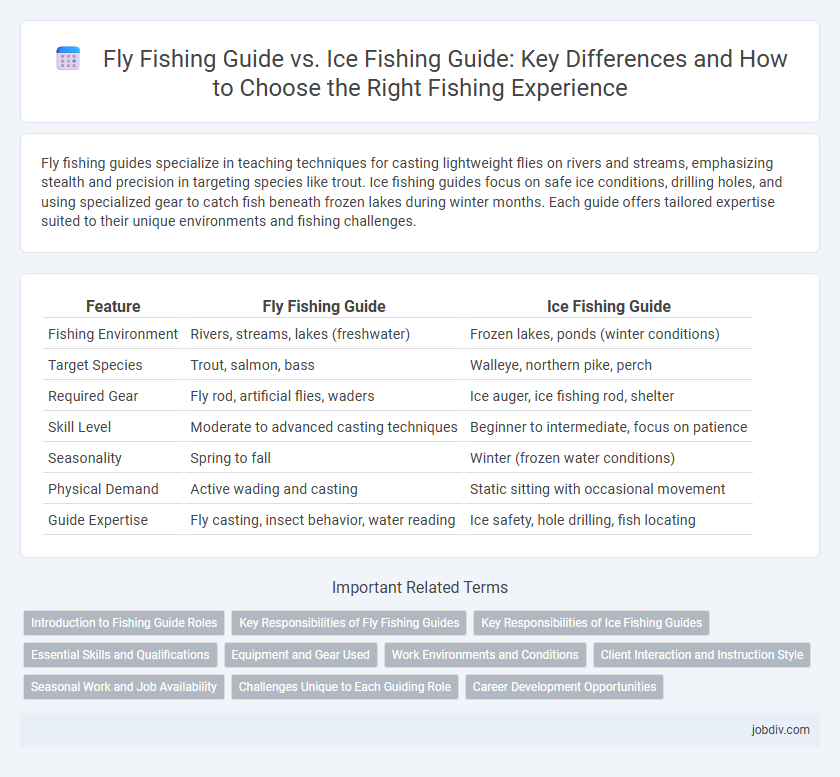Fly fishing guides specialize in teaching techniques for casting lightweight flies on rivers and streams, emphasizing stealth and precision in targeting species like trout. Ice fishing guides focus on safe ice conditions, drilling holes, and using specialized gear to catch fish beneath frozen lakes during winter months. Each guide offers tailored expertise suited to their unique environments and fishing challenges.
Table of Comparison
| Feature | Fly Fishing Guide | Ice Fishing Guide |
|---|---|---|
| Fishing Environment | Rivers, streams, lakes (freshwater) | Frozen lakes, ponds (winter conditions) |
| Target Species | Trout, salmon, bass | Walleye, northern pike, perch |
| Required Gear | Fly rod, artificial flies, waders | Ice auger, ice fishing rod, shelter |
| Skill Level | Moderate to advanced casting techniques | Beginner to intermediate, focus on patience |
| Seasonality | Spring to fall | Winter (frozen water conditions) |
| Physical Demand | Active wading and casting | Static sitting with occasional movement |
| Guide Expertise | Fly casting, insect behavior, water reading | Ice safety, hole drilling, fish locating |
Introduction to Fishing Guide Roles
Fly fishing guides specialize in teaching anglers techniques for casting lightweight flies in rivers and streams, emphasizing precision and presentation to catch species like trout and salmon. Ice fishing guides focus on navigating frozen bodies of water, drilling safe holes, and locating fish beneath the ice, targeting species such as walleye, perch, and northern pike. Both types of guides provide expert knowledge on local ecosystems, equipment selection, and safety practices essential for a successful and enjoyable fishing experience.
Key Responsibilities of Fly Fishing Guides
Fly fishing guides specialize in teaching clients precise casting techniques, selecting appropriate fly patterns, and locating ideal freshwater habitats such as rivers and streams. Their key responsibilities include providing expert advice on entomology to match flies with local insect life and ensuring safety while wading in variable water conditions. Fly fishing guides also customize trips based on skill levels, helping anglers improve accuracy and fish targeting on species like trout and bass.
Key Responsibilities of Ice Fishing Guides
Ice fishing guides specialize in preparing and maintaining safe ice conditions, identifying prime fishing spots beneath frozen surfaces, and assisting clients with specialized equipment such as augers and insulated shelters. Their responsibilities include educating anglers on ice safety protocols, managing bait and tackle suitable for cold-water species, and facilitating continuous monitoring of weather and ice thickness. Expertise in emergency response and first aid is essential to ensure client safety during unpredictable ice conditions.
Essential Skills and Qualifications
Fly fishing guides must master casting techniques, insect identification, and reading water currents to locate fish, while ice fishing guides require expertise in safe ice assessment, drill operation, and shelter setup. Both guides need strong knowledge of local fish species, weather patterns, and effective bait or lure selection to enhance client success. Certification in first aid and fishing regulations compliance are essential qualifications for ensuring safety and legal adherence in both disciplines.
Equipment and Gear Used
Fly fishing guides rely on lightweight, flexible rods and specialized fly reels designed for precise casting of artificial flies, combined with tapered fly lines and a selection of fly patterns matched to local insect life. Ice fishing guides use short, sturdy rods with sensitive tips to detect subtle bites through frozen lakes, paired with portable ice augers for drilling holes and insulated shelters to withstand harsh cold conditions. Both types of guides emphasize gear tailored to specific environments and fishing techniques to maximize catch efficiency.
Work Environments and Conditions
Fly fishing guides typically operate in rivers, streams, and freshwater lakes with variable weather conditions, requiring mobility and knowledge of aquatic insect hatches and fish behavior. Ice fishing guides work in frozen lakes or rivers where safety precautions for ice thickness, cold temperatures, and specialized equipment are critical. Both guides must adapt to environmental challenges, but ice fishing demands additional focus on weather hazards and shelter management.
Client Interaction and Instruction Style
Fly fishing guides emphasize personalized, hands-on instruction, tailoring techniques to individual skill levels while fostering a patient and encouraging learning environment. Ice fishing guides prioritize safety and equipment handling, offering more structured, group-based guidance to navigate cold-weather conditions effectively. Both guide types engage clients through clear communication and expert tips, but fly fishing leans toward artistic technique mastery, whereas ice fishing focuses on practical survival and efficiency skills.
Seasonal Work and Job Availability
Fly fishing guides predominantly work during spring through early fall when rivers and streams are accessible and fish are active, resulting in a highly seasonal yet consistent demand. Ice fishing guides experience peak job availability in winter months, often facing a shorter, more intense season dependent on safe ice conditions. Both roles require flexibility and adaptation to seasonal environmental changes, impacting income stability and work opportunities.
Challenges Unique to Each Guiding Role
Fly fishing guides navigate constantly changing river conditions, requiring expertise in casting techniques and insect hatch awareness to ensure successful catch rates. Ice fishing guides face challenges related to safety and ice thickness assessment, demanding precise skill in drilling holes and managing cold-weather gear. Both roles require specialized knowledge but differ significantly in environmental hazards and equipment handling.
Career Development Opportunities
Fly fishing guides often find career development opportunities through specialized training in aquatic ecosystems and casting techniques, allowing them to work in diverse river and stream environments. Ice fishing guides develop skills in winter survival, ice safety, and specialized equipment operation, which can lead to seasonal employment in colder regions and niche tourism markets. Both career paths offer potential growth in tourism, outdoor education, and conservation roles, but ice fishing guides may have more limited geographic options compared to fly fishing guides.
Fly Fishing Guide vs Ice Fishing Guide Infographic

 jobdiv.com
jobdiv.com